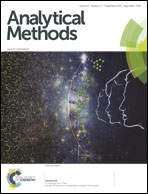Simultaneous determination of eight active components in chloroform extracts from raw and vinegar-processed Genkwa flos using HPLC-MS and identification of the hepatotoxic ingredients with an HL-7702 cell
Abstract
Genkwa flos, a traditional Chinese medicine, displays severe hepatotoxicity when it is excessively or chronically used in its raw form. It has been proven that the chloroform extracts within Genkwa flos are responsible for its hepatotoxicity. Note that the vinegar process procedure may weaken the toxicity and enhance the therapeutic effects. This study was conducted to investigate a quality control method of the chloroform extracts of Genkwa flos and to identify the potential hepatotoxic ingredients using HL-7702 cells. A LC-MS method was developed and fully validated to simultaneously determine three flavonoids (apigenin, genkwanin and hydroxygenkwanin), three lignans (syringaresinol, medioresinol and matairesinol) and two diterpene esters (yuanhuacine and genkwadaphnin) in the chloroform extracts. With satisfactory linearity, precision, repeatability, stability and recovery, the developed method was then applied to compare the content changes of the eight compounds in raw and processed herbs. After processing, the content of flavonoids increased, the lignans did not obviously change, while the diterpene esters decreased. Compared with the blank control group, the HL-7702 cells treated with the two diterpene esters exhibited obvious morphology change, viability decrease and increase in the level of hepatic marker enzymes in cell culture supernatant. The study showed a comprehensive quantitative method to simultaneously determine eight compounds of the chloroform extracts from Genkwa flos, and they indicated that yuanhuacine and genkwadaphnin could be two of the potential hepatotoxic substances of the herb.


 Please wait while we load your content...
Please wait while we load your content...